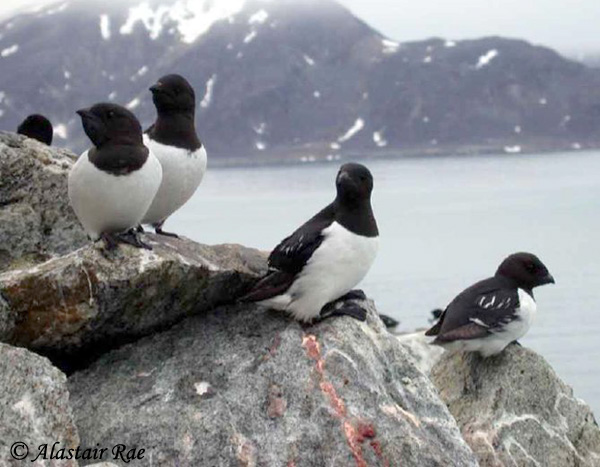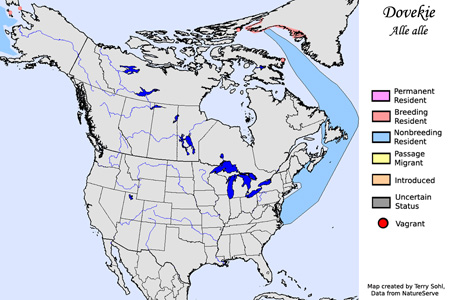| Length: 8 inches | Wingspan: 15 inches | Seasonality: Non-resident in South Dakota |
| ID Keys: Small size, black upperparts, head, and neck with white belly and undertail, tiny stubby bill | ||
 The
Dovekie is a tiny member of the Auk family, standing only 8 inches tall but
wearing the same basic black-and-white plumage pattern of some of the larger
Auk species. They are sometimes called "Little Auks". Despite
their small size, they nest furthern north than any of the Auk species, with
huge numbers nesting in traditional nesting sites like those in northwestern
Greenland. Small colonies can be found in a very few spots off the
coast of western Alaska and northeastern Canada. Even during the
winter months, most Dovekie stay in the far north, where they can often be
found around the edge of the pack ice. Small numbers can occasionally
be found southward along the Atlantic Coast in winter, and more rarely,
storm events may blow small numbers inland.
The
Dovekie is a tiny member of the Auk family, standing only 8 inches tall but
wearing the same basic black-and-white plumage pattern of some of the larger
Auk species. They are sometimes called "Little Auks". Despite
their small size, they nest furthern north than any of the Auk species, with
huge numbers nesting in traditional nesting sites like those in northwestern
Greenland. Small colonies can be found in a very few spots off the
coast of western Alaska and northeastern Canada. Even during the
winter months, most Dovekie stay in the far north, where they can often be
found around the edge of the pack ice. Small numbers can occasionally
be found southward along the Atlantic Coast in winter, and more rarely,
storm events may blow small numbers inland.
Habitat: Found on rocky coastlines and islands during the summer breeding season, in the far northern Arctic. In other seasons, found in cold ocean waters, often at the very edge of the pack ice, and often far out to sea.
Diet: Feeds heavily on small crustaceans such as amphipods and copepods. Also will occasionally feed on small fish, marine worms, and mollusks.
Behavior: Feeds by diving and swimming underwater. Not a deep diver, with most foraging occurring relatively close to the water's surface.
Nesting: The nest of a Doviekie is a simple layer of pebbles lined with lichens, placed in a crack or crevice on a cliff face or on a rocky slope. The female lays a single egg, and both parents take turns incubating it. Upon hatching, both parents help to feed the youngster.
Song: Has a high screeching trill call that rises and falls in pitch. Otherwise, generally silent.
Migration: Breeds in very far north Arctic locations, with northwestern Greenland having the biggest nesting populations in the Western Hemisphere. Large numbers remain in the far north as long as open water is available. Small numbers may stray as far south as New England (and rarely further) in the winter.
Interactive eBird Map: Click here to access an interactive eBird map of Dovekie sightings
Similar Species: If seen well, unlikely to be confused with another species within its range, due to its small size and unique features compared to other auk species.
Conservation Status: Populations appear to be strong and relatively stable. The IUCN currently lists the Dovekie as a species of "Least Concern".
Further Information: 1) Cornell's All About Birds - Dovekie
2) AvianWeb.com - Dovekie
3) Alaska Seabird Information Series - Dovekie
Photo Information: Photo taken by Alastair Rae - July 14th, 2004 - Svalbard - Licensed under Creative Commons Attribution-ShareAlike 2.0 Generic License.
| Click below for a higher-resolution map |
 |
| South Dakota Status: Non-resident in South Dakota |
Additional Dovekie Photos (coming soon!)
